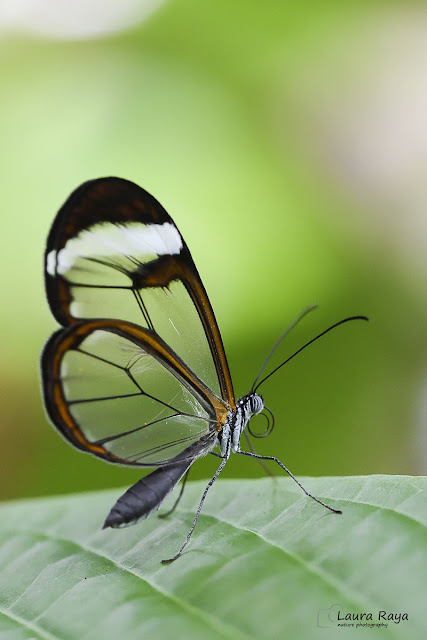Buenos días,
en el post anterior os enseñaba las primeras fotos que realicé a la especie Greta oto, y os traigo hoy la segunda parte de la sesión (Podéis ver la primera parte AQUÍ). Como os conté, la fama para esta especie es obvia tras ver sus llamativas alas transparentes. Pero, ¿a qué se debe esta característica tan peculiar?
Realmente no son transparentes, de hecho, si os fijáis, puede apreciarse en algunas fotografías. Lo que parece ser de cristal es en realidad, el tejido entre las pequeñas venas de las mariposas. Las escamas que recubren la superficie alar no tienen coloración, siendo de las únicas especies que carecen de ella.
Pero ¿a qué se debe esta ausencia de pigmentación en el tejido intervenal? Es simplemente el resultado de un proceso evolutivo, en el que se han visto favorecidas ante la depredación. Esta característica les sirve de camuflaje entre la vegetación, ya que el tejido alar no es capaz de absorber la luz ni de dispersarla, por lo que pasan desapercibidas con mayor facilidad.
El hecho de que carezcan de color, no las hace más frágiles, el nombre vulgar de mariposa de cristal, con el que a menudo se le conoce, está alejado de la realidad, ya que son tan resistentes como las alas de cualquier otra mariposa.
A mí personalmente me parece espectacular. Una verdadera obra maestra de la naturaleza.
¿Y a vosotros? Espero que os gusten las fotografías y, como siempre, seguimos en contacto por instagram (AQUÍ) y facebook (AQUÍ).
L.R.
Good Morning,
In the previous post I showed you the first photos I took of the species Greta oto, and I bring you today the second part of the session (You can see the first part AQUÍ). As I told you, the fame for this species is obvious after seeing its striking transparent wings. But why is this peculiar characteristic?
They really are not transparent, in fact, if you look, it can be seen in some photographs. What appears to be glass is actually the tissue between the small veins of the butterflies. The scales that cover the wing surface do not have coloration, being the only species that lack it.
But why is this absence of pigmentation in the interventional tissue? It is simply the result of an evolutionary process, in which they have been favored by predation. This characteristic serves as camouflage between the vegetation, since the wing fabric is not able to absorb light or disperse it, so they go unnoticed more easily.
The fact that they lack color, does not make them more fragile, the vulgar name of glass butterfly, with which it is often known, is far from reality, since they are as resistant as the wings of any other butterfly.
I personally find it spectacular. A true masterpiece of nature.
And to you? I hope you like the pictures and, as always, we keep in touch by instagram (AQUÍ) and facebook (AQUÍ).
L.R.














No hay comentarios:
Publicar un comentario